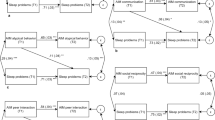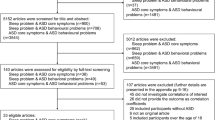Abstract
We examined the association of two types of restricted and repetitive behaviors, repetitive sensory motor (RSM) and insistence on sameness (IS), with sleep problems in children with autism spectrum disorder (ASD). Participants included 532 children (aged 2–17) who participated in the Autism Speaks Autism Treatment Network research registry. Confirmatory factor analysis of the Autism Diagnostic Interview-Revised detected the presence of RSM and IS. RSM behaviors were positively associated with parent-reported sleep problems, and this relationship remained significant after controlling for anxiety symptoms. IS was not significantly associated with sleep problems. Better understanding of the relationship between specific types of repetitive behaviors and sleep problems may allow providers to tailor interventions to the individual presentations of their patients with ASD.
Similar content being viewed by others
References
Achenbach, T. M. (1991). Manual for the child behavior checklist 4–18 and 1991 profile. Burlington, VT: University of Vermont, Department of Psychiatry.
American Psychiatric Association. (2000). Diagnostic and statistical manual of mental disorders (4th ed., text rev.). Washington, DC: American Psychiatric Association.
American Psychiatric Association. (2013). Diagnostic and statistical manual of mental disorders (5th ed.). Arlington, VA: American Psychiatric Association.
Bentler, P. M. (2006). On tests and indices for evaluating structural models. Personality and Individual Differences, 42, 825–829.
Bentler, P. M., & Chou, C. P. (1987). Practical issues in structural modeling. Sociological Methods and Research, 16, 78–117.
Bishop, S. L., Hus, V., Duncan, A., Huerta, M., Gotham, K., Pickles, A., et al. (2013). Subcategories of restricted and repetitive behaviors in children with autism spectrum disorders. Journal of Autism and Developmental Disorders, 3, 1287–1297.
Bishop, S. L., Richler, J., & Lord, C. (2006). Association between restricted and repetitive behaviors and nonverbal IQ in children with autism spectrum disorders. Child Neuropsychology, 4(5), 247–267.
Bodfish, J. W., Symons, F. J., Parker, D. E., & Lewis, M. H. (2000). Varieties of repetitive behavior in autism: Comparisons to mental retardation. Journal of Autism and Developmental Disorders, 30(3), 237–243.
Chan, A. S., Sze, S. L., Nicolson, Y. S., Lau, E. M., & Cheung, M.-c. (2013). A Chinese mind-body exercise improves self-control of children with autism: A randomized controlled trial. PLoS One, 8(7), e68184. doi:10.1371/journal.pone.0068184.
Chorpita, B. F. (2007). Modular cognitive-behavioral therapy for childhood anxiety disorders. New York, NY: The Guilford Press.
Christensen, D. L., Baio, J., Braun, K. V., et al. (2016). Prevalence and characteristics of autism spectrum disorder among children aged 8 years—Autism and developmental disabilities monitoring network, 11 sites, United States, 2012. Morbidity and Mortality Weekly Report, 65(3), 1–23.
Couturier, J. L., Speechley, K. N., Steele, M., Norman, R., Stringer, B., & Nicholson, R. (2005). Parental perception of sleep problems in children of normal intelligence with pervasive developmental disorders: Prevalence, severity, and pattern. Journal of the American Academy of Child and Adolescent Psychiatry, 44, 815–822.
Cuccaro, M., Shao, Y., Grubber, J., Slifer, M., Wolpert, C. M., Donnelly, S. L., et al. (2003). Factor analysis of restricted and repetitive behaviors in autism using the autism diagnostic interview-r. Child Psychiatry and Human Development, 34(1), 3–17.
Goldman, S. E., McGrew, S., Johnson, K. P., Richdale, A. L., Clemons, T., & Malow, B. A. (2011). Sleep is associated with problem behaviors in children and adolescents with autism spectrum disorders. Research in Autism Spectrum Disorders, 5, 1223–1229.
Goldman, S. E., Richdale, A. L., Clemons, T., & Malow, B. A. (2012). Parental sleep concerns in autism spectrum disorders: Variations from childhood into adolescence. Journal of Autism and Developmental Disorders, 42, 531–538.
Goldman, S. E., Surdyka, K., Cuevas, R., Adkins, K., Wang, L., & Malow, B. A. (2009). Defining the sleep phenotype in children with autism. Developmental Neuropsychology, 34, 560–573.
Goodlin-Jones, B. L., Sitnick, S. L., Tang, K., Liu, J., & Anders, T. F. (2008). The children’s sleep habits questionnaire in toddlers and preschool children. Journal of Developmental and Behavioral Pediatrics, 29, 82–88.
Goodlin-Jones, B., Tang, K., Liu, J., & Anders, T. F. (2009). Sleep problems, sleepiness and daytime behavior in preschool-age children. Journal of Child Psychology and Psychiatry, 50, 1532–1540.
Gotham, K., Bishop, S. L., Hus, V., Huerta, M., Lund, S., Buja, A., et al. (2013). Exploring the relationship between anxiety and insistence on sameness in autism spectrum disorders. Autism Research, 6, 33–41.
Hollway, J. A., & Aman, M. G. (2011). Sleep correlates of pervasive developmental disorders: A review of the literature. Research in Developmental Disabilities, 32, 1399–1421.
Hollway, J. A., Aman, M. G., & Butter, E. (2013). Correlates and risk markers for sleep disturbance in participants of the autism treatment network. Journal of Autism and Developmental Disorders, 43, 2830–2843.
Honey, E., McConachie, H., Turner, M., & Rodgers, J. (2012). Validation of the repetitive behavior questionnaire for use with children with autism spectrum disorder. Research in Autism Spectrum Disorder, 6, 355–364.
Hu, L.-T., & Bentler, P. M. (1999). Cutoff criteria for fix indexes in covariance structure analysis: Conventional criteria versus new alternatives. Structural Equation Modeling, 6, 1–55.
IBM Corp. (2013). IBM SPSS Statistics for windows 22.0. Armonk, NY: IBM Corp.
Krakowiak, P., Goodlin-Jones, B., Hertz-Piccotto, I., Croen, L. A., & Hansen, R. L. (2008). Sleep problems in children with autism spectrum disorders, developmental delays, and typical development: A population-based study. Journal of Sleep Research, 17(2), 197–206.
Lam, K. S. L., & Aman, M. G. (2007). The repetitive behavior scale-revised: Independent validation in individuals with autism spectrum disorders. Journal of Autism and Developmental Disorders, 37(5), 855–866.
Lam, K. S. L., Bodfish, J. W., & Piven, J. (2008). Evidence for three subtypes of repetitive behaviors in autism that differ in familiality and association with other symptoms. Journal of Child Psychology and Psychiatry, 49(11), 1193–1200.
Langen, M., Durston, S., Kas, M. J. H., van Engeland, H., & Staal, W. G. (2011). The neurobiology of repetitive behavior. Neuroscience and Biobehavioral Review, 35, 356–365.
Lidstone, J., Uljaravic, M., Sullivan, J., Rodgers, J., McConachie, H., Freeston, M., et al. (2014). Relations among restricted and repetitive behaviors, anxiety, and sensory features in children with autism spectrum disorder. Research in Autism Spectrum Disorders, 8, 82–92.
Lord, C., Rutter, M., DiLavoe, P. C., & Risi, S. (1999). Autism diagnostic observation schedule (WSP ed.). Los Angeles, CA: Western Psychological Services.
Lord, C., Rutter, M., & LeCouteur, A. (1994). Autism Diagnostic Interview-Revised: A revised version of a diagnostic interview for caregivers of individual with possible pervasive developmental disorders. Journal of Autism and Developmental Disorders, 24, 659–685.
Malow, B. A., Adkins, K. W., McGrew, S. G., Wang, L., Goldman, S. E., Fawkes, D., et al. (2012). Melatonin for sleep in children with autism: A controlled trial examining dose, tolerability, and outcomes. Journal of Autism and Developmental Disorders, 42(8), 1729–1737.
Malow, B. A., Adkins, K. W., Reynolds, A., Weiss, S. K., Loh, A., Fawkes, D., et al. (2014). Parent-based sleep education for children with autism spectrum disorders. Journal of Autism and Developmental Disorders, 44(1), 216–228.
Malow, B. A., Marzec, M., McGrew, S. G., Wang, L., & Stone, W. (2006). Characterizing sleep in children with autism spectrum disorders: A multidimensional approach. Sleep, 29(12), 1563–1571.
Malow, B. A., & McGrew, S. G. (2008). Sleep disturbances and autism. Sleep Medicine Clinics, 3, 479–488.
Mayes, S. D., & Calhoun, S. L. (2009). Variables related to sleep problems in children with autism. Research in Autism Spectrum Disorders, 3, 931–941.
Mazurek, M. O., & Petroski, G. F. (2015). Sleep problems in children with autism spectrum disorder: Examining the contributions of sensory over-responsivity and anxiety. Sleep Medicine, 16, 270–279.
Mirenda, P., Smith, I. M., Vaillancourt, T., Georgiades, S., Duke, E., Szatmari, P., et al. (2010). Validating the repetitive behavior scale-revised in young children with autism spectrum disorder. Journal of Autism and Developmental Disorders, 40, 1521–1530.
Mooney, E., Gray, K., Tonge, B., Sweeney, D., & Taffe, J. (2009). Factor analytic study of repetitive behavior in young children with pervasive developmental disorders. Journal of Autism and Developmental Disorders, 39, 765–774.
Owens, J. A. (2015). Behavioral sleep problems in children. In R. D. Chervin & A. G. Hoppin (Eds.), UptoDate. Waltham, MA. Accessed 26 June 2015.
Owens, J. A., Spirito, A., & Mcguinn, M. (2000). The children’s sleep habits questionnaire (CSHQ): Psychometric properties of a survey instrument for school-aged children. Sleep, 23, 1043–1051.
Richdale, A. L., & Schreck, K. A. (2009). Sleep problems in autism spectrum disorders: Prevalence, nature and possible biopsychosocial aetiologies. Sleep Medicine Reviews, 13, 403–411.
Richler, J., Bishop, S. L., Kleinke, J. R., & Lord, C. (2007). Restricted and repetitive behaviors in young children with autism spectrum disorders. Journal of Autism and Developmental Disorders, 37, 73–85.
Richler, J., Huerta, M., Bishop, S. L., & Lord, C. (2010). Developmental trajectories of restricted and repetitive behaviors and interests in children with autism spectrum disorders. Developmental Psychopathology, 22(1), 55–69.
Rodgers, J., Glod, M., Connolly, B., & McConachie, H. (2012). The relationship between anxiety and repetitive behaviors in autism spectrum disorder. Journal of Autism and Developmental Disorders, 42, 2404–2409.
SAS Institute Inc. (2014). SAS for windows, Version 9.4.. Cary, NC: SAS Institute Inc.
Schreck, K. A., Mulick, J. A., & Smith, A. F. (2004). Sleep problems as possible predictors of intensified symptoms of autism. Research in Developmental Disabilities, 25(1), 57–66.
Szatmari, P., Georgiades, S., Bryson, S., et al. (2006). Investigating the structure of the restricted, repetitive behaivours and interests domain of autism. Journal of Child Psychology and Psychiatry, 47(6), 582–590.
Wood, J. J., Drahota, A., Sze, K., Har, K., Chiu, A., & Langer, D. A. (2008). Cognitive behavioral therapy for anxiety in children with autism spectrum disorders: A randomized controlled trial. Journal of Child Psychology and Psychiatry, 50(3), 224–234.
Acknowledgments
This project is/was supported by the Health Resources and Services Administration (HRSA) of the U.S. Department of Health and Human Services (HHS) under cooperative agreement UA3 MC11054—Autism Intervention Research Network on Physical Health. This information or content and conclusions are those of the author and should not be construed as the official position or policy of, nor should any endorsements be inferred by HRSA, HHS or the U.S. Government. This work was conducted through the Autism Speaks Autism Treatment Network serving as the autism intervention research network on physical health.
Author Contributions
RH and BM conceived of the study, participated in its design and coordination. The data was previously collected and all authors were involved in the analysis and interpretation of the data, the drafting of the manuscript and its critical revision. All authors read and approved the final manuscript.
Author information
Authors and Affiliations
Corresponding author
Ethics declarations
Conflict of interest
Rachel Hundley declares that she has no conflicts of interest. Amy Shui declares that she has no conflicts of interest. Beth Malow declares that she has no conflicts of interest.
Informed Consent
Informed consent was obtained from all individual participants when they enrolled into the ASATN registry database. As the current study involved retrospective review formal consent was not required.
Ethical Approval
All procedures performed in this study were in accordance with the institutional research committee and with the 1964 Helsinki declaration and its later amendments/comparable ethical standards.
Animal Rights
This article does not contain any studies with animals performed by any of the authors.
Rights and permissions
About this article
Cite this article
Hundley, R.J., Shui, A. & Malow, B.A. Relationship Between Subtypes of Restricted and Repetitive Behaviors and Sleep Disturbance in Autism Spectrum Disorder. J Autism Dev Disord 46, 3448–3457 (2016). https://doi.org/10.1007/s10803-016-2884-4
Published:
Issue Date:
DOI: https://doi.org/10.1007/s10803-016-2884-4




